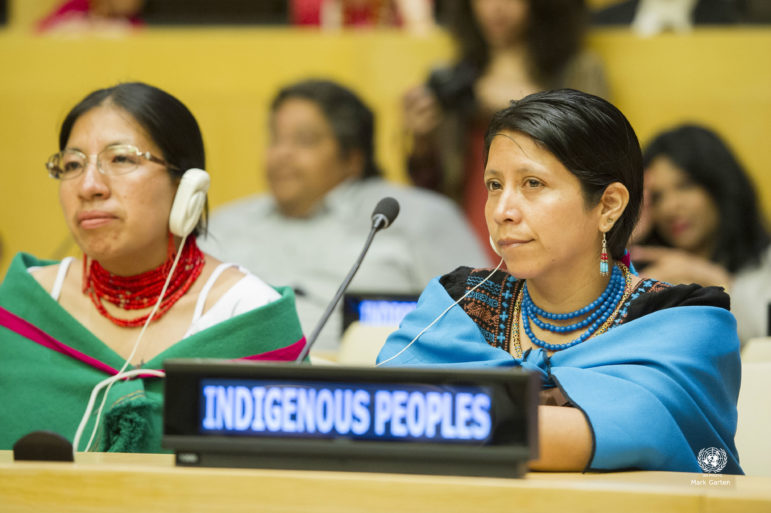

Plaque indicating IIndigenous land reserve on the Brazilian Amazon. Image: Shutterstock
Guide Resource
GIJN/NAJA Guide for Indigenous Investigative Journalists
Chapter Guide Resource
Data Journalism on Indigenous Communities
Chapter Guide Resource
Land Ownership: Community Rights Under Threat
Chapter Guide Resource
Investigating Criminal Justice
Chapter Guide Resource
Exposing Exploitation and Corruption
Chapter Guide Resource
Covering the Climate Crisis
Chapter Guide Resource
Investigating Murdered or Missing Persons
Chapter Guide Resource
Indigenous Data Sovereignty
Chapter Guide Resource
Getting Documents, Dealing with Whistleblowers, and Staying Safe
Chapter Guide Resource
GIJC23 Indigenous Investigations Webinar
The claims by Indigenous peoples to the land on which they farm, graze animals, hunt and live are often unrecognized, tenuous, and vulnerable.
Despite their historic use of the land, they often lack legal security.
The exploitation of natural resources located on traditional community land is one of the most frequent problems for Indigenous communities. And “commons” land may be sold by governments into private hands.
The absence of clear ownership rights has many consequences.
Secure land rights are considered vital in protecting the environment, combating climate change, creating economic well-being, improving the treatment of women, preserving health, maintaining socio-cultural cohesion, and more.
This GIJN/NAJA guide provides suggestions on what to investigate and where to find helpful information about land ownership and related issues.
The financial stakes are high, and so is the human cost.
Governments and corporations around the world are making it increasingly difficult for Indigenous peoples and local communities to protect lands and forests.
The cost in human lives was described in a 2018 report by Victoria Tauli-Corpuz, UN Special Rapporteur on the Rights of Indigenous Peoples, titled Attacks and Criminalization of Indigenous Peoples Defending their Lands and Rights. (Also exists in Spanish.)

Farmers in Bolivia. Photo: Flickr/Aquistbe
Investigative Ideas
Below are a few ideas for investigative stories inspired by community resistance to exploitation and previous investigations by journalists and nongovernmental organizations.
- Is community land being expropriated?
- Is community land being exploited?
- Is forcing people off community land creating refugees?
- What are the effects of the evolution from community land tenure systems that predate colonization to the western model of individual ownership?
- Who is profiting from arrangements with corporations to extract minerals, harvest timber, farm, pump water, etc.?
- Are Indigenous peoples getting a fair share of profits?
- What are the environmental effects of extractive and agricultural uses of the land?
- What happens when conservation goals and tribal rights and practices conflict?
- Are national and international laws meant to protect the land rights of Indigenous peoples being enforced?
- Does collective management of resources bring broader benefits to a larger group of people?
- What governance structure works best for communal land?
- Are Indigenous leaders being good custodians of the lands?
- How do property laws and practices adversely affect women?
- What data exists, or doesn’t exist, regarding community lands?
- Who controls the collection and use of the data?
Property Rights
Legal recognition of land rights and the mapping of tribal areas can protect and empower Indigenous peoples. However, there are still issues with defending these rights despite many national and international systemic means to do so.
“The rights of ownership and possession of the peoples concerned over the lands which they traditionally occupy shall be recognized,” states Part 2 of C169 – Indigenous and Tribal Peoples Convention, adopted at the 1989 General Conference of the International Labour Organisation.
ILO Convention 169 is designed to protect tribal peoples’ rights, but is ratified by only 23 governments. It is one of four international agreements, according to a summary by Land Portal.
Other regional and national protective mechanisms exist, so any exploration of land rights issues requires a familiarity in sometimes-complicated law and history.
“[W]hile international human rights law now firmly protects the land rights of indigenous peoples, substantial gaps remain with regard to non-Indigenous land users such as peasants, smallholder farmers, and cattle breeders, creating the urgent need to expand the existing rules to these vulnerable groups,” according to a 2019 article in the Human Rights Law Review.
National laws exist but many laws have loopholes or are not enforced. See summaries by LandMark. The International Work Group for Indigenous Affairs, which has a page devoted to land rights, describes ongoing disputes, most prominently in its 600-page country-by-country report The Indigenous World 2019.
Another big picture report (2019) is Global Report on the Situation of Lands, Territories and Resources of Indigenous Peoples prepared by the Indigenous Peoples Major Group (IPMG).
Vague laws sometimes exist, such as Peru’s Law 28736, known as the “law for the protection of communities in isolation or in a state of initial contact,” which nevertheless permits the extraction of resources (such as gas or oil) in Indigenous reserves “out of public necessity.” For a good overview of land issues in Peru that’s also more widely relevant, read this article by Yoly Gutierrez in Landscape News.
The IWGIA report gives the following account of Chad: “Given the absence of any legal clarifications on land, there are still many ongoing problems. The closure of transhumance corridors, privatisation of water sources, and land grabbing remain a major obstacle, preventing indigenous peoples’ access to land and natural resources.”
Understanding the history of the particular nation being studied is key to understanding land issues.
“The genesis of the land quagmire between the Kalenjin and Kikuyus in the Rift Valley region (of Kenya) traces back to the 1940s, which the British colonial government exacerbated by settling the Kikuyus in the area,” states an article in The Elephant.
Land laws can be complicated, too, as portrayed by a 2019 article in The Observer covering the Mailo land tenure system in Uganda, which is the most complex among the country’s four tenure systems. The piece by Geoffrey Mulindwa is accompanied by the results of a public opinion poll about providing land certificates for customary land.
Policy differences can be complex. Core debates center around whether community lands, sometimes known as “commons,” or individual property ownership is the better option. But the answer of what is in the best interest of a community may vary depending on circumstances.
For example, this CityLab article addresses whether individual property rights would ease housing problems on Canadian reserves.
How to best govern community lands is another complex topic with variations in approach seen around the world. For a taste of this issue, see a Forests Lands article about a meeting of the 17th International Association for the Study of the Commons (IASC) Global Conference 2019.
The trends are not uniformly dismal. One academic study describes a number of promising trends, including a rise in the number of laws catering specifically to the identification, registration, and governance of community property.
How land ownership is handled affects many things, such as conservation of natural resources. (See more in this guide’s chapter on the climate crisis.)
Consistent attacks on tribal lands have occurred through attempts at exploiting natural resources such as mining minerals, harvesting wood, drilling for oil, planting non-traditional crops, and more. (See this guide’s chapter on exposing exploitation and corruption, which addresses the extractive industries.)
It’s not all bleak. For a positive view on the effects of land reform, read an article in Geospatial World by Avneep Dhingra, Significance of Land rights for Empowerment.

Photo: Flickr/Joe Brusky
Mapping Issues
One problem for investigative work? Land ownership records are often weak, nonexistent, not public, or a mix of all the above.
Researching land boundaries and ownership relies on national records. In many countries, records do not exist or are inaccurate. Sometimes a lack of government resources is a widespread problem. In addition, corruption can lead to the falsification of records. In many developed countries, learning who owns a piece of land is easily done through an online search. In other places, such work requires visiting government offices and digging through paper records, if they exist. They are not available in most parts of the world and the names of owners are often kept confidential.
Determining what records are available requires knowledge about the laws and regulations governing property. Potential alternative or accompanying sources are local officials, real estate brokers, and lawyers.
Learn more about what can be discovered and where to look by visiting the GIJN resource Land Ownership Records: So Useful, but Challenging to Find.
The adequacy of land records themselves is an under-told part of the story.
In Australia, “There is growing demand from Indigenous Australian polities for local data to support local planning and, while much can be accessed from conventional sources, data are not captured in ways that provide for ‘culture-smart information,’” according to Diane Smith in a 2016 book, Indigenous Data Sovereignty (Chapter 7). Smith is a senior research fellow and convener of the Higher Degree by Research Program at The Australian National University’s National Centre for Indigenous Studies.
In some places, costly and complicated efforts to improve records systems are being discussed or are underway, supported by international organizations.
Cadasta is an NGO that has created tools to document land rights and conducts participatory mapping exercises with communities.
For more on this topic, see GIJN’s resource Land and Property Ownership: A Story Beneath Our Feet.
Alternative Sources
Fortunately, land records are not the only potential sources of information. Scouring court records about property disputes may also prove productive.
Researchers have had luck with official gazettes and government publications of record.
They may reveal requests for land use changes and building permits. Records about specific types of land rights, such as mining rights, may exist in specialized government offices and information about farm subsidy payments may also be helpful.
Besides relying on government records, researchers suggest checking company reports and websites, media reports, advertisements, and social media.
Potential alternative or accompanying sources are local officials, real estate brokers, and lawyers.
Onsite visits also may be valuable.
In an example of a government impeding disclosure, the Indonesian government in May 2019 permitted palm oil companies not to share their plantation data with other parties, including external consultants, NGOs, and multilateral and foreign agencies, Mongabay reported. The government cited reasons such as corporate secrecy, anti-competitive practices, and national security. Environmental activists in Indonesia denounced the policy.
Using Satellite Images
Satellite imagery is a valuable tool that is being used to identify such things as encroachment on community lands, illegal mining, loss of wetlands, deforestation, and construction of mansions by officials.
Journalists may want to seek help by contacting NGOs or satellite imagery providers. Norway recently announced a plan to take images of deforestation and make them available for free.
An explanation of how satellites can help detect land grabs by monitoring changes in the vegetation is provided here by the Remote Sensing Research Group (University of Bonn).
The World Resources Institute (WRI) on its forest monitoring platform Global Forest Watch (GFW) showed how much tree cover was lost in 2018 and where this loss happened. Also see an article on the data by the investigative group Mongabay, which partnered with WRI.
Read more and find out who will help from GIJN’s resource Finding and Using Satellite Images.
Drones may also be valuable for investigations, but require resources and sophisticated analysis. One study of their use by Indigenous communities highlighted the complexities.

Petroglyphs in Nevada. Photo: Pixabay
Landing on Specialized Websites
A few international websites specialize in monitoring “community properties,” a term used for areas controlled by Indigenous peoples.
Landmark: The Global Platform of Indigenous and Community Lands produced by this NGO displays geo-referenced information on collectively-held and used lands worldwide. It consolidates the numerous ongoing local, national, and regional efforts to map and document Indigenous and community lands.
Land Matrix is an independent global land monitoring initiative that promotes transparency and accountability in decisions over large-scale land acquisitions (LSLAs) in low- and middle-income countries across the world. This online open access platform has maps and data on major land deals.
Rights and Resources is a collaborative effort engaged in land and forest policy reforms in close to 20 countries throughout Africa, Asia, and Latin America. It has maintained the global database on “who owns the world’s forests?” since 2005, following Forest Trends’ 2002 analysis of the same name, and expanded the data beyond forests in 2015.
Survival United is an international NGO focused on protecting Indigenous peoples, and often works on land expropriation issues. For example, in June 2019 it documented that the Yanomami territory in Brazil was under attack by up to 10,000 illegal gold miners.
Forest Peoples Programme is an NGO that works on land rights, explaining its role in part by stating: “Evidence is mounting that where they have secure tenure, communities and indigenous peoples are often the most capable custodians of the planet’s natural capital, yet communities are not, or are only minimally, involved in official decision-making and management of these areas.” Its work includes producing reports such as Challenges and opportunities in the adoption of community forestry by local communities and indigenous peoples in the Republic of Congo.
The Coalition Against Land Grabbing is a coalition of Indigenous peoples from Palawan (the Philippines). Very large quarterly “Bulletins” compile stories about land and Indigenous peoples from around the world, and more, such as articles about human rights violations and deforestation. The Bulletin for the first quarter of 2019 runs over 200 pages, citing dozens of articles, arranged by region and country.
The Columbia Center for Sustainable Development has three related databases of contracts in many countries and “plain language” descriptions to help stakeholders understand these often complex legal documents. The repositories include benefit-sharing agreements, leases, memoranda of understanding (MOUs), and revenue-sharing agreements concluded in the context of agriculture, forestry, mining, oil and gas extraction, renewable energy, and other natural resource projects. See the Open Land Contracts, Resource Contracts, and Open Community Contracts.
The International Work Group for Indigenous Affairs (IWGIA) has a page on land rights.
A good policy overview is contained in a 2018 World Resources Institute report, The Scramble for Land Rights, about how to formalize customary rights and better protect community land. It reviews the law and practice of 33 community and company procedures for acquiring formal land rights in 15 countries. WRI identified five key problems:
- In seeking to formalize their land rights, communities face complex and sometimes insurmountable legal, technical, and evidentiary requirements.
- In most countries surveyed, significant areas of customary land may be excluded in certificates or titles granted to communities.
- Community procedures generally take years to decades, while land acquisition procedures for companies typically range from one month to five years.
- Communities have narrow windows of opportunity for land formalization.
- Communities receive inadequate and sporadic support, compared to dedicated and sustained support for investors.
Prindex, a joint initiative of the Global Land Alliance and Overseas Development Institute, published a study in 2019 documenting that hundreds of millions of people — one in four — across 33 countries surveyed during 2018 expect to lose their homes or other property.
The Global Landscapes Forum is a venue for discussion of Indigenous land issues.
For a summary of the 2019 GLF meeting held in Bonn, Germany, see this article in The Business Mirror.
The Land Policy Initiative is a joint program of the tripartite consortium consisting of the African Union Commission (AUC), the African Development Bank (AfDB) and United Nations Economic Commission for Africa (ECA). Focused on Africa, the website includes publications such as Framework and Guidelines on Landpolicy in Africa (sic).
For good background see this 2012 report by the ICCA Consortium. (ICCA stands for Indigenous and Conserved Areas Consortium.)
Land Conflict Watch monitors land issues in India and reports about 700 ongoing land conflicts affecting almost 8 million people.
The Indian Law Resource Center has information on land rights in the US, Brazil, and other countries.
In Canada, a 2019 study, Assessing the Duty to Consult, said the duty to consult Indigenous peoples, which is a constitutional obligation, creates uncertainty because the specific requirements for consultation are determined on a case-by-case basis.
The National Native Title Tribunal in Australia was established in 1994. It makes decisions; conducts inquiries, reviews, and mediations; and assists parties with native title applications and Indigenous land use agreements. Registers provide detailed information on Indigenous land use agreements.
Internationally Focused Resources
Here are some additional resources concerning international protections for property rights.
The Intergovernmental Panel on Climate Change (IPCC) is the United Nations body for assessing the science related to climate change. An IPCC report released in August of 2019, Climate Change and Land, recognizes that securing land rights is a critical solution to the climate crisis. Also see a statement by Indigenous groups from 42 countries.
A broad backgrounder on the topic, Indigenous Peoples’ Collective Rights to Lands, Territories, and Resources, was prepared by the United Nations Permanent Forum on Indigenous Issues.
A good overview on international legal protections for Indigenous land rights was done by Minority Rights Group International.
Land Portal is a site run by a nonprofit organization based in the Netherlands and has a special section on Indigenous land issues.
Specialized News Sources
A few websites exist that specialize in following news about land rights internationally, often with attention to Indigenous communities.
Forests News frequently covers land rights issues.
Place from the Thomson Reuters Foundation is another good source of land news.
Vulnerability of Indigenous Women
A 2017 study by Rights and Resources said that up to 2.5 billion people hold and use the world’s community lands, yet the tenure rights of women “are seldom acknowledged or protected by national laws.”
Many Indigenous and rural women perceive their land and resource rights to be insecure, according to a study by Rosa Luz Duran, an associate professor from the University of Lima, Peru. Duran looked at 250 households in 20 different Indigenous communities in Peru and found that women’s perceptions of their land tenure security have a measurable effect on their household’s well-being.
“When it comes to women’s tenure rights, even laws that recognize communal and collective land tenure systems may not be enough if they are not gender sensitive,” according to an article in Forest News by Augusta Dwyer that delves into a variety of scenarios, such as male control of decision-making.
In Tanzania, stories supported by the European Journalism Centre explore why some older widows, who don’t have male descendants, marry younger women who do, in order to maintain land rights. “We used paralegals on the ground to tell us about how many female marriages there were in 10 different villages and it turned out that the number of female marriages now represented over 20% of households,” reporter Marta Martinez explained.
Another reminder of the policy complications is seen in this Thomson Reuters Foundation article, Kenyan tribe divided over women’s land rights after landmark ruling.
Prindex conducted a study documenting that women feel less secure than men about their property.
For an investigative example, see an article in The Elephant by Diana Kindi, Women and the Land: Who Owns it?
Process Can Be a Story, Too
Although possibly dull and procedural, the subject of how land use decisions are made is an important one. In many countries, procedures for community consultation are weak.
For example, a panel of three judges ruled that the Ecuadorian government had failed to properly consult with the Waorani tribe before auctioning off the mineral and oil rights on Waorani land.
A story by Oxpeckers explores in detail the meaning of consultation over mining that would affect the Umgungundlovu community in Xolobeni, South Africa.
In Russia, the right of participation for land use decisions in Indigenous territories has been virtually eliminated, the IWGIA wrote in The Indigenous World 2019. In the same report, the IWGIA reported that the Moroccan government “commenced a procedure for demarcating land without any prior direct consultation with the population.”

















